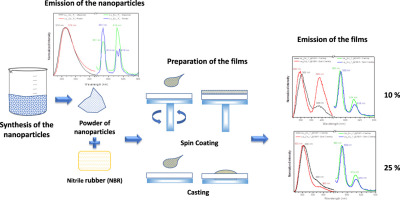Journal of Solid State Chemistry ( IF 3.2 ) Pub Date : 2017-12-28 , DOI: 10.1016/j.jssc.2017.12.026 Henrique de L. Secco , Fabio F. Ferreira , Laura O. Péres

|
The combination of materials to form hybrids with unique properties, different from those of the isolated components, is a strategy used to prepare functional materials with improved properties aiming to allow their application in specific fields. The doping of lanthanum fluoride with other rare earth elements is used to obtain luminescent particles, which may be useful to the manufacturing of electronic devices’ displays and biological markers, for instance. The application of the powder of nanoparticles has limitations in some fields; to overcome this, the powder may be incorporated in a suitable polymeric matrix. In this work, lanthanum fluoride nanoparticles, undoped and doped with cerium and europium, were synthesized through the co-precipitation method in aqueous solution. Aiming the formation of solid state films, composites of nanoparticles in an elastomeric matrix, the nitrile rubber (NBR), were prepared. The flexibility and the transparency of the matrix in the regions of interest are advantages for the application of the luminescent composites. The composites were applied as films using the casting and the spin coating techniques and luminescent materials were obtained in the samples doped with europium and cerium. Scanning electron microscopy images showed an adequate dispersion of the particles in the matrix in both film formation techniques. Aggregates of the particles were detected in the samples which may affect the uniformity of the emission of the composites.
中文翻译:

铈和euro掺杂的LaF 3纳米粒子的荧光复合膜的简单制备
材料的组合形成具有独特特性的杂化物,这些特性不同于分离出的组分,是一种用于制备功能性材料的策略,旨在使其在特定领域中得到应用。氟化镧与其他稀土元素的掺杂可用于获得发光粒子,例如,这些发光粒子可用于制造电子设备的显示器和生物标记。纳米颗粒粉末的应用在某些领域有局限性。为了克服这个问题,可以将粉末掺入合适的聚合物基质中。在这项工作中,通过共沉淀法在水溶液中合成了未掺杂和掺杂铈和euro的氟化镧纳米颗粒。为了形成固态膜,制备了弹性体基质(丁腈橡胶,NBR)中纳米颗粒的复合材料。感兴趣区域中基质的柔韧性和透明性对于发光复合材料的应用是有利的。使用浇铸和旋涂技术将复合材料制成薄膜,并在掺有and和铈的样品中获得了发光材料。扫描电子显微镜图像显示了在两种成膜技术中颗粒在基质中的充分分散。在样品中检测到颗粒的聚集体,这可能会影响复合材料发射的均匀性。感兴趣区域中基质的柔韧性和透明性对于发光复合材料的应用是有利的。使用浇铸和旋涂技术将复合材料制成薄膜,并在掺有and和铈的样品中获得了发光材料。扫描电子显微镜图像显示了在两种成膜技术中颗粒在基质中的充分分散。在样品中检测到颗粒的聚集体,这可能会影响复合材料发射的均匀性。感兴趣区域中基质的柔韧性和透明性对于发光复合材料的应用是有利的。使用浇铸和旋涂技术将复合材料制成薄膜,并在掺有and和铈的样品中获得了发光材料。扫描电子显微镜图像显示了在两种成膜技术中颗粒在基质中的充分分散。在样品中检测到颗粒的聚集体,这可能会影响复合材料发射的均匀性。扫描电子显微镜图像显示了在两种成膜技术中颗粒在基质中的充分分散。在样品中检测到颗粒的聚集体,这可能会影响复合材料发射的均匀性。扫描电子显微镜图像显示了在两种成膜技术中颗粒在基质中的充分分散。在样品中检测到颗粒的聚集体,这可能会影响复合材料发射的均匀性。











































 京公网安备 11010802027423号
京公网安备 11010802027423号